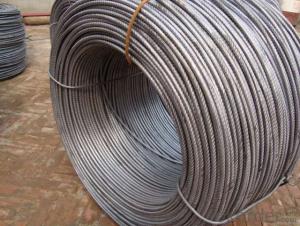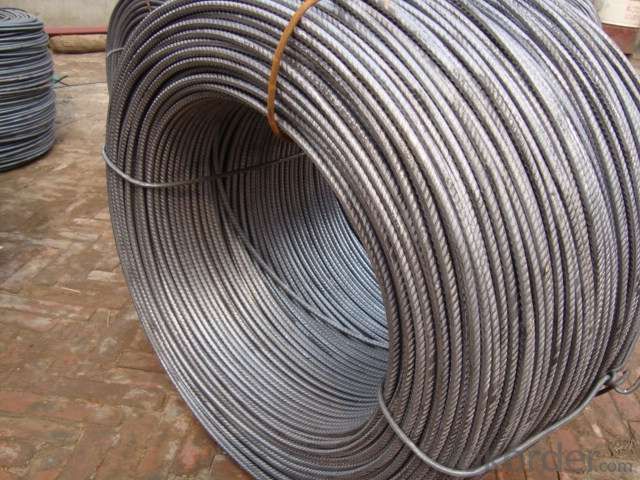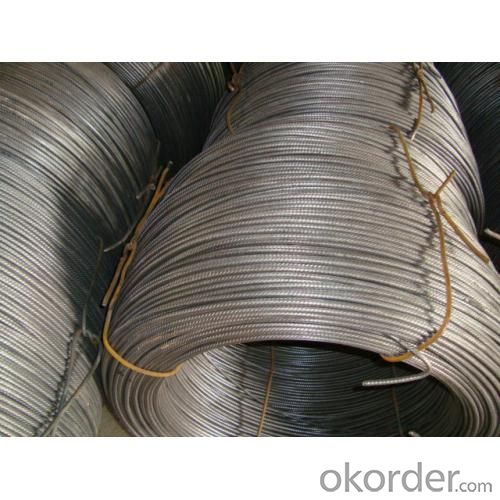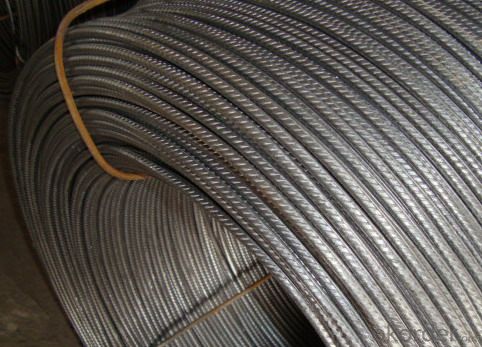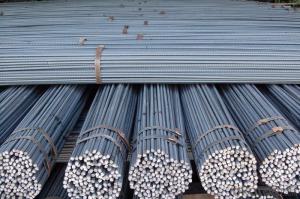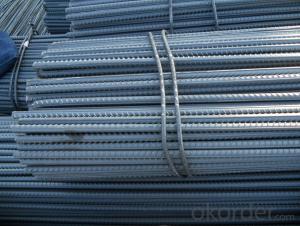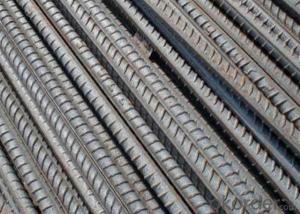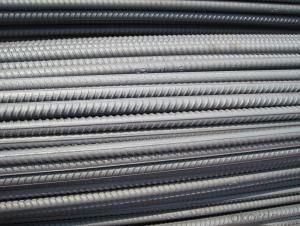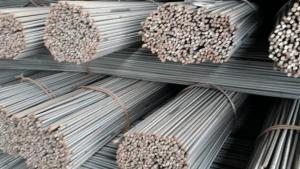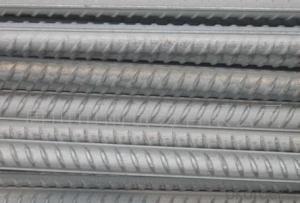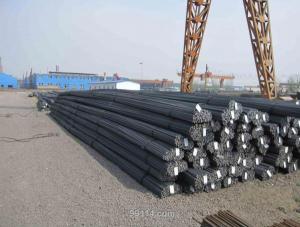High Quality Steel Deformed Bar HRB400 6/8/10mm
- Loading Port:
- Tianjin
- Payment Terms:
- TT or LC
- Min Order Qty:
- 50 m.t
- Supply Capability:
- 10000 m.t/month
OKorder Service Pledge
OKorder Financial Service
You Might Also Like
High Quality Steel Deformed Bar HRB400 6/8/10mm
Product Description:
Specifications of High Quality Steel Deformed Bar HRB400 6/8/10mm:
Standard | GB | HRB400 | |
Diameter | 6mm,8mm,10mm | ||
Length | In coils | ||
Place of origin | Hebei, China mainland | ||
Advantages | exact size, regular package, chemical and mechanical properties are stable. | ||
Type | Hot rolled deformed steel bar | ||
Chemical Composition of High Quality Steel Deformed Bar HRB400 6/8/10mm: (Please kindly find our chemistry of our material based on HRB400 as below for your information)
Grade | Technical data of the original chemical composition (%) | ||||||
C | Mn | Si | S | P | V | ||
HRB400 | ≤0.25 | ≤1.60 | ≤0.80 | ≤0.045 | ≤0.045 | 0.04-0.12 | |
Physical capability | |||||||
Yield Strength (N/cm²) | Tensile Strength (N/cm²) | Elongation (%) | |||||
≥400 | ≥570 | ≥14 | |||||
Theoretical weight and section area of High Quality Steel Deformed Bar HRB400 6/8/10mm as below for your information:
Diameter(mm) | Section area (mm²) | Mass(kg/m) | Weight of 12m bar(kg) |
6 | 28.27 | 0.222 | 2.664 |
8 | 50.27 | 0.395 | 4.74 |
10 | 78.54 | 0.617 | 7.404 |
Usage and Applications of High Quality Steel Deformed Bar HRB400 6/8/10mm:
Deformed bar is widely used in buildings, bridges, roads and other engineering construction. Big to highways, railways, bridges, culverts, tunnels, public facilities such as flood control, dam, small to housing construction, beam, column, wall and the foundation of the plate, deformed bar is an integral structure material. With the development of world economy and the vigorous development of infrastructure construction, real estate, the demand for deformed bar will be larger and larger.
Packaging & Delivery of High Quality Steel Deformed Bar HRB400 6/8/10mm:
Packaging Detail: products are packed in bundle and then shipped by container or bulk vessel, deformed bar is usually naked strapping delivery, when storing, please pay attention to moisture proof. The performance of rust will produce adverse effect.
Each bundle weight: 2-3MT, or as required
Payment term: TT or L/C
Delivery Detail: within 45 days after received advanced payment or LC.
Label: to be specified by customer, generally, each bundle has 1-2 labels
Trade terms: FOB, CFR, CIF
FAQ:
Q1: Why buy Materials & Equipment from OKorder.com?
A1: All products offered byOKorder.com are carefully selected from China's most reliable manufacturing enterprises. Through its ISO certifications, OKorder.com adheres to the highest standards and a commitment to supply chain safety and customer satisfaction.
Q2: How do we guarantee the quality of our products?
A2: We have established an advanced quality management system which conducts strict quality tests at every step, from raw materials to the final product. At the same time, we provide extensive follow-up service assurances as required.
Q3: How soon can we receive the product after purchase?
A3: Within three days of placing an order, we will arrange production. The shipping date is dependent upon the quatity, how many sizes you want and the plan of production, but is typically 1 month to 2 month days from the beginning of production.
Images of High Quality Steel Deformed Bar HRB400 6/8/10mm:
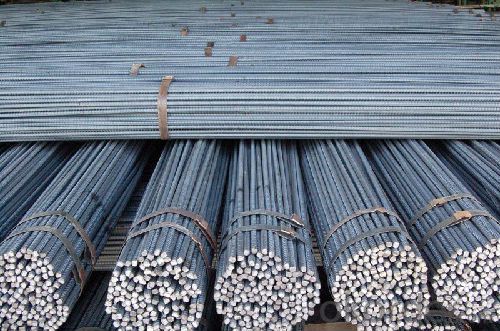
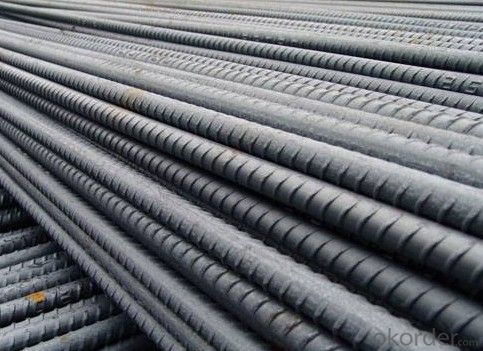
*If you would like to get our price, please inform us the size, standard/material and quantity. Thank you very much for your attention.
- Q: Can steel rebars be used in residential swimming pool construction?
- Yes, steel rebars can be used in residential swimming pool construction. Steel rebars provide structural reinforcement to the pool walls and floor, ensuring stability and durability.
- Q: What is the minimum cover required for steel rebars in concrete structures?
- The minimum cover required for steel rebars in concrete structures typically depends on the specific design requirements and the environmental conditions. However, as a general guideline, it is commonly recommended to have a minimum cover of at least 1.5 inches (38 mm) for rebars in most concrete structures. This cover helps protect the steel from corrosion, provides fire resistance, and ensures adequate bond strength between the rebar and concrete. It is important to consult the relevant building codes, specifications, and engineering professionals to determine the precise minimum cover requirements for a specific project.
- Q: Can steel rebars be used in the construction of office buildings?
- Yes, steel rebars can be used in the construction of office buildings. Steel rebars are commonly used as reinforcement in concrete structures, including office buildings. They provide strength and stability to the concrete, making it more resistant to cracking and bending. The use of steel rebars helps to ensure the structural integrity of the building, especially in areas of high stress or load-bearing requirements. Additionally, steel rebars are durable and long-lasting, making them a reliable choice for construction projects.
- Q: Can steel rebars be used in high-rise buildings?
- Yes, steel rebars can be used in high-rise buildings. Steel rebars provide excellent strength and durability, making them suitable for reinforcing concrete structures in tall buildings. The use of steel rebars ensures structural stability and enhances the overall strength of high-rise buildings, making them a common choice in construction.
- Q: When did the 1305 rebar contract become a major contract?
- The thread has 3 different contracts, which have been completed. They are continuous thread (1211 contract) and thread four (1303 contract). 1305 into the thread, even Sihui next month, into the thread, it will continue until April 13 years.
- Q: What are steel rebars used for?
- Steel rebars are used in construction to provide strength and reinforcement to concrete structures, such as buildings, bridges, and highways.
- Q: Are there any environmental concerns related to the production of steel rebars?
- The production of steel rebars raises several environmental concerns, including the significant energy requirement for steel production. To produce steel, large amounts of fossil fuels like coal and natural gas are used, contributing to greenhouse gas emissions and climate change. Another concern is the extraction and mining of iron ore, the main raw material for steel production. This process can result in deforestation, habitat destruction, and soil erosion. Moreover, mining generates substantial waste material that can contaminate nearby water sources. In addition, the steel production process emits air pollutants such as particulate matter, sulfur dioxide, and nitrogen oxides. These pollutants can harm air quality and human health, causing respiratory problems and contributing to the formation of smog. It is worth noting that the steel industry is taking steps to address these environmental concerns. For instance, many steel producers are adopting more energy-efficient technologies and exploring alternative energy sources to reduce carbon emissions. Additionally, the recycling of steel is becoming more widespread, conserving resources and reducing the environmental impact of steel production. Overall, although the production of steel rebars does present environmental concerns, ongoing efforts are being made to mitigate these impacts and make the process more sustainable.
- Q: How do steel rebars affect the durability of concrete structures?
- Steel rebars play a crucial role in enhancing the durability of concrete structures. By reinforcing the concrete, rebars help to increase its tensile strength, which is otherwise low compared to its compressive strength. This is crucial because concrete is highly effective in resisting compressive forces, but it is weak in withstanding tension or bending forces. When concrete structures are subjected to external forces like vibrations, wind, or earthquakes, the rebars absorb the tension and bending forces, preventing the concrete from cracking or collapsing. This ensures that the structure remains intact and stable. Without the presence of steel rebars, concrete structures would be more prone to damage and failure under such circumstances. Additionally, steel rebars also enhance the durability of concrete structures by preventing corrosion. When embedded in concrete, rebars act as a protective barrier against moisture and oxygen, which are primary agents that lead to the corrosion of steel. By preventing the penetration of these harmful elements, rebars significantly extend the lifespan of the concrete structure. Moreover, steel rebars provide dimensional stability to concrete structures. As concrete tends to shrink and expand due to temperature changes and moisture variations, the presence of rebars helps to counteract these movements. This prevents cracks from forming and ensures the structural integrity of the concrete. In summary, steel rebars greatly enhance the durability of concrete structures by increasing their tensile strength, preventing cracking and collapse, protecting against corrosion, and providing dimensional stability. Their presence is essential for constructing long-lasting and reliable concrete structures that can withstand various external forces and environmental conditions.
- Q: What are the different types of steel rebars available in the market?
- There are several types of steel rebars available in the market, including conventional carbon steel rebars, epoxy-coated rebars, galvanized rebars, stainless steel rebars, and high-strength rebars. Each type has specific properties and advantages depending on the intended application.
- Q: Can steel rebars be used in structures with long spans?
- Yes, steel rebars can be used in structures with long spans. Steel rebars are commonly used as reinforcement in concrete structures, including those with long spans such as bridges, high-rise buildings, and stadiums. The high tensile strength and durability of steel rebars make them suitable for withstanding the forces and stresses that occur in such structures.
Send your message to us
High Quality Steel Deformed Bar HRB400 6/8/10mm
- Loading Port:
- Tianjin
- Payment Terms:
- TT or LC
- Min Order Qty:
- 50 m.t
- Supply Capability:
- 10000 m.t/month
OKorder Service Pledge
OKorder Financial Service
Similar products
Hot products
Hot Searches
Related keywords
